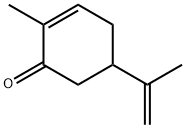CARVEOL
Synonym(s):(−)-Carveol, mixture of isomers;p-Mentha-6,8-dien-2-ol
- CAS NO.:99-48-9
- Empirical Formula: C10H16O
- Molecular Weight: 152.23
- MDL number: MFCD00062993
- EINECS: 202-757-4
- SAFETY DATA SHEET (SDS)
- Update Date: 2025-01-27 09:38:02

What is CARVEOL?
Chemical properties
Clear colorless to slightly yellow liquid
Chemical properties
Carveol has spearmint-like odor.
Occurrence
In small amounts, sometimes esterified, it has been reported present in caraway seeds, spearmint, orange juice, mango and eucalyptus oil.
The Uses of CARVEOL
Carveol, is a constituent of spearmint essential oil in the form of cis-(?)-carveol. It can be used as a fragrance ingredient, and as a flavor additive in the food industry. It is also found that its alpha-trans-dihydroxy derivative, possesses potent antiparkinsonian activity in animal models.
What are the applications of Application
Carveol is a terpene that inhibits mammary carcinogenesis
Definition
ChEBI: A limonene monoterpenoid that is cyclohex-2-en-1-ol substituted by a methyl group at position 2 and a prop-1-en-2-yl group at position 5.
Aroma threshold values
Detection: 4 ppm
General Description
Clear colorless liquid. Insoluble in water.
Air & Water Reactions
Insoluble in water.
Reactivity Profile
Flammable and/or toxic gases are generated by the combination of alcohols with alkali metals, nitrides, and strong reducing agents. They react with oxoacids and carboxylic acids to form esters plus water. Oxidizing agents convert them to aldehydes or ketones. Alcohols exhibit both weak acid and weak base behavior. They may initiate the polymerization of isocyanates and epoxides.
Health Hazard
ACUTE/CHRONIC HAZARDS: Toxic.
Synthesis
The various d-, l- and dl- (cis- and trans-, respectively) forms have been prepared synthetically and isolated by means of the dinitrobenzoates according to Amvers’ law. They are prepared by oxidation of limonene or, better, from carvone.
Properties of CARVEOL
| Melting point: | 24-25 °C |
| Boiling point: | 226-227 °C751 mm Hg(lit.) |
| Density | 0.958 g/mL at 25 °C(lit.) |
| refractive index | n |
| FEMA | 2247 | CARVEOL |
| Flash point: | 209 °F |
| storage temp. | 2-8°C |
| solubility | Chloroform, Ethyl Acetate (Slightly) |
| form | neat |
| pka | 14.60±0.60(Predicted) |
| form | Liquid |
| Specific Gravity | 0.96 |
| color | Clear Colourless to Light Yellow |
| Odor | at 100.00 %. minty spearmint cooling green herbal caraway spicy |
| optical activity | [α]22/D 115°, c = 1 in chloroform |
| Water Solubility | Partly soluble in water. Soluble in alcohol, ethanol and DMSO. |
| JECFA Number | 381 |
| BRN | 6269416 |
| Dielectric constant | 11.2(18℃) |
| EPA Substance Registry System | Carveol (99-48-9) |
Safety information for CARVEOL
| Signal word | Warning |
| Pictogram(s) |
 Exclamation Mark Irritant GHS07 |
| GHS Hazard Statements |
H315:Skin corrosion/irritation H319:Serious eye damage/eye irritation H335:Specific target organ toxicity, single exposure;Respiratory tract irritation |
| Precautionary Statement Codes |
P261:Avoid breathing dust/fume/gas/mist/vapours/spray. P264:Wash hands thoroughly after handling. P264:Wash skin thouroughly after handling. P271:Use only outdoors or in a well-ventilated area. P280:Wear protective gloves/protective clothing/eye protection/face protection. P302+P352:IF ON SKIN: wash with plenty of soap and water. P305+P351+P338:IF IN EYES: Rinse cautiously with water for several minutes. Remove contact lenses, if present and easy to do. Continuerinsing. |
Computed Descriptors for CARVEOL
New Products
3-Iodophenylacetic acid 3-Pyridineacetonitrile, α-hydroxy- 2-Propanamine, 1-chloro-, hydrochloride (9CI) 3-(hexyloxy)-4-(pyridin-3-yl)-1,2,5-thiadiazole 2-Hexyn-1-ol Dibenzo-18-crown-6 Nickel(II) perchlorate hexahydrate, 98% 4-Bromophenylacetonitrile, 95% 3-Bromo-4-fluoroaniline, 97% Sodium tetraborate decahydrate, 98% Palladium(II) acetate, trimer, Pd 99% 4-Bromo-2-chlorotoluene, 97% N N Dimethylformamide Dimethyl Acetal (Dmf Dma) 2,3-Dichloro Benzoyl Cyanide [Side Chain] Bis(2-Chloroethyl) Amine Hydrochloride L-Glutamic Acid Diethyl Ester Hydrochloride 5-(Difluoromethoxy)-2-Mercaptobenzimidazole 1-Ethyl-3-(3-Dimethylaminopropyl)-Carbodiimide Hydrochloride [EDC Hcl] 1,4-Napthoquinone Bromoiodomethane Sodium Bicarbonate Methylene Dichloride (MDC) Ethyl Acetate Indole-3-Carbinol (I3C)Related products of tetrahydrofuran
You may like
-
 (−)-Carveol, mixture of isomers CAS 99-48-9View Details
(−)-Carveol, mixture of isomers CAS 99-48-9View Details
99-48-9 -
 17604-74-9 3-Pyridineacetonitrile, α-hydroxy- 98+View Details
17604-74-9 3-Pyridineacetonitrile, α-hydroxy- 98+View Details
17604-74-9 -
 131987-69-4 98+View Details
131987-69-4 98+View Details
131987-69-4 -
 Cyclohexane, (2-propynyloxy)- 67967-07-1 98+View Details
Cyclohexane, (2-propynyloxy)- 67967-07-1 98+View Details
67967-07-1 -
 764-60-3 2-Hexyn-1-ol 98+View Details
764-60-3 2-Hexyn-1-ol 98+View Details
764-60-3 -
 2-Propanamine, 1-chloro-, hydrochloride (9CI) 98+View Details
2-Propanamine, 1-chloro-, hydrochloride (9CI) 98+View Details
5968-21-8 -
 3-Iodophenylacetic acid 1878-69-9 98+View Details
3-Iodophenylacetic acid 1878-69-9 98+View Details
1878-69-9 -
 132945-75-6 (S)-1-Boc-3-methanesulfonyloxy-pyrrolidine 98+View Details
132945-75-6 (S)-1-Boc-3-methanesulfonyloxy-pyrrolidine 98+View Details
132945-75-6








